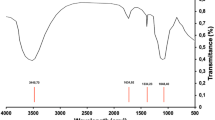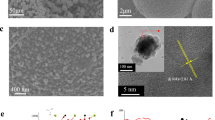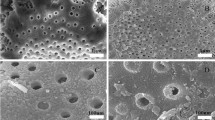Abstract
THE practical importance of hydrated aluminium oxides in the terrestrial and aquatic environments, is well known primarily through the significant role they have in the retention of nutrients in agriculture1 and in the control of pollutants such as phosphate in eutrophication processes2. Anion adsorption on hydrous aluminium oxides has also attracted the interest of engineers mainly because in tertiary waste-water treatment, the removal of phosphate with alum salts seems to be through adsorption on the hydrated oxide floc particles3,4. Consequently the adsorption of anions on hydrated aluminium oxides has been extensively investigated. These studies have shown that organic anions such as citrate compete with phosphate for adsorption sites on the surfaces of the hydrated aluminium oxides thereby decreasing their capacity to retain phosphate5–8. Our studies9 show that citric acid even at very low concentrations hampers the formation of crystalline aluminium hydroxides. We report here that due to the hindrance of the crystallisation processes, the .retention of phosphate by the hydrolytic reaction products of aluminium is enhanced and not reduced when they are precipitated in the presence of low concentration of citric acid which represents an organic acid commonly occurring in nature.
This is a preview of subscription content, access via your institution
Access options
Subscribe to this journal
Receive 51 print issues and online access
$199.00 per year
only $3.90 per issue
Buy this article
- Purchase on Springer Link
- Instant access to full article PDF
Prices may be subject to local taxes which are calculated during checkout
Similar content being viewed by others
References
Wada, K. & Harward, M. E. Adv. Agron. 26, 211–260 (1974).
Syers, J. K., Harris, R. F. & Armstrong, D. E. J. environ. Qual. 2, 1–14 (1973).
Chen, B. H. H., King, P. H. & Randall, C. W. Environ. Lett. 6, 129–138 (1974).
Eckenfelder, W. W. in Water Quality Engineering for Practicing Engineers (ed. Eckenfelder, W. W.) 220–224 (Barnes and Noble, New York, 1970).
Swenson, R. M., Cole, C. V. & Sieling, D. H. Soil Sci. 67, 3–22 (1949).
Struthers, P. H. & Sieling, D. H. Soil Sci. 69, 205–213 (1950).
Nagarajah, S., Posner, A. M. & Quirk, J. P. Nature 228, 83–84 (1970).
Chen, Y. S., Butler, J. N. & Stumm, W. J. Colloid Interface Sci. 43, 421–436 (1973).
Ng Kee Kwong, K. F. & Huang, P. M. Clays Clay Miner. 23, 164–165 (1975); Soil Sci. Soc. Am. J. 41, 692–697 (1977).
Gallet, J. P. & Paris, R. A. Anal. chim. Acta 39, 341–348 (1967).
Toy, A. D., Smith, T. D. & Pilbrow, J. R. Aust. J. Chem. 26, 1889–1892 (1973).
Hsu, P. H. in Minerals in Soil Environments (eds Dixon, J. B. & Weed, S. B.) Ch. 4 (Soil Sci. Soc. Am. Inc., Madison, Wisconsin, 1977).
Eltantawy, I. M. & Arnold, P. W. J. Soil Sci. 24, 232–238 (1973).
Greenland, D. J. Soil Sci. 111, 34–41 (1971).
Author information
Authors and Affiliations
Rights and permissions
About this article
Cite this article
NG KEE KWONG, K., HUANG, P. Sorption of phosphate by hydrolytic reaction products of aluminium. Nature 271, 336–338 (1978). https://doi.org/10.1038/271336a0
Received:
Accepted:
Published:
Issue Date:
DOI: https://doi.org/10.1038/271336a0
This article is cited by
-
Soil phosphorus fractions, aluminum, and water retention as affected by microbial activity in an Ultisol
Plant and Soil (1990)
-
Lime-aluminium-phosphorus interactions and the growth of Leucaena leucocephala
Plant and Soil (1990)
-
Effects of liming on phosphate availability in acid soils
Plant and Soil (1982)
Comments
By submitting a comment you agree to abide by our Terms and Community Guidelines. If you find something abusive or that does not comply with our terms or guidelines please flag it as inappropriate.



